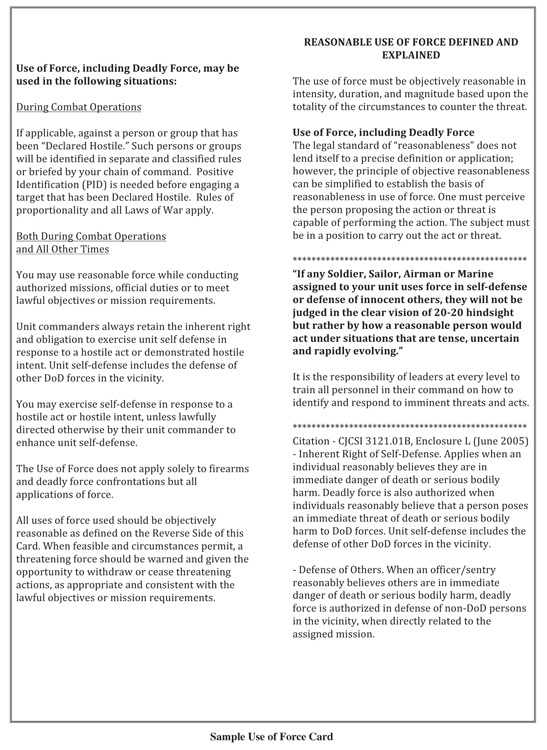Length in meters ½-wavelength of operating frequency
Height Variable (lead-in not over 13 meters)
Radiation 360 degrees
Field Expedient Rc-292 Antenna
The field expedient 292 antenna is used with FM radios. It is used in place of the RC-292 when such an antenna is not available. Principal parts consist of:
•65 feet of gutted 550 cord.
•Five insulators (see note 1 on page 341).
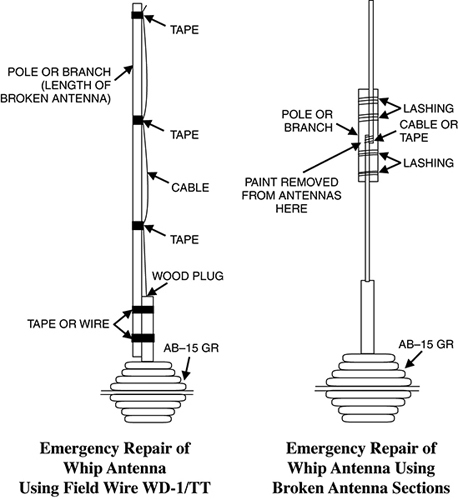
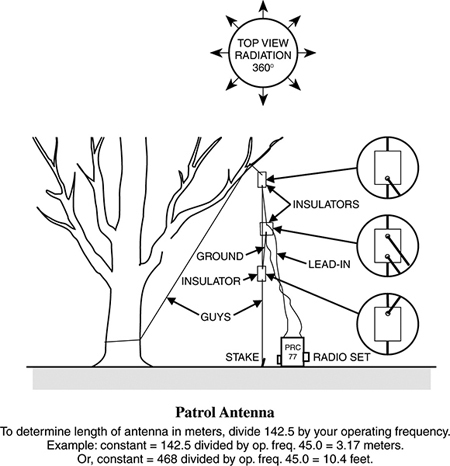
•Four 6.5-foot lengths of antenna elements (16-gauge copper wire, see note 2 below).
•Three 1-foot-long gutted 550 cord (see note 3 below).
•50 feet of coax cable (RG-58 or RH-174).
•Solderless BNC connector (see note 4 below).
Notes:
1.Insulators should be made of a semiflexible plastic (i.e. spoons, flashlight lenses, etc.).
2.Use wire from GRA-50 dipole antenna for the radiator element.
3.The 550 cord end is tied in a loop to create a slip knot to put ends of sticks through during execution.
4.Once coax is connected, use electrical tape to secure and cover bare wires.
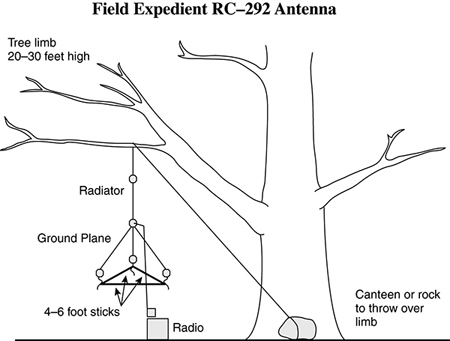
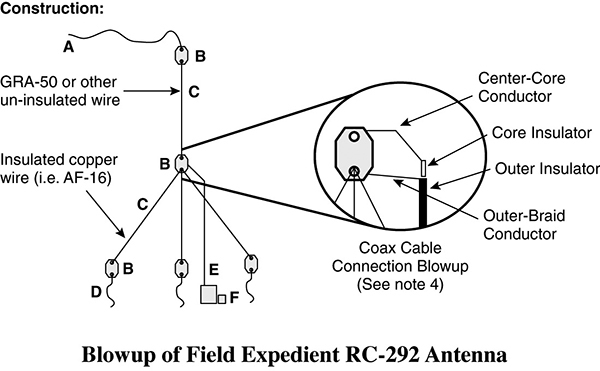
Horizontal Antennas
When the situation does not require mobility and the antenna group RC-292 is not available, you can get greater distance by using the long-wire horizontal antenna. The physical length in meters of one wavelength for a given operating frequency can be computed as follows:
All horizontal antennas described here are fed by connecting the receiver-transmitter to one end of the antenna.
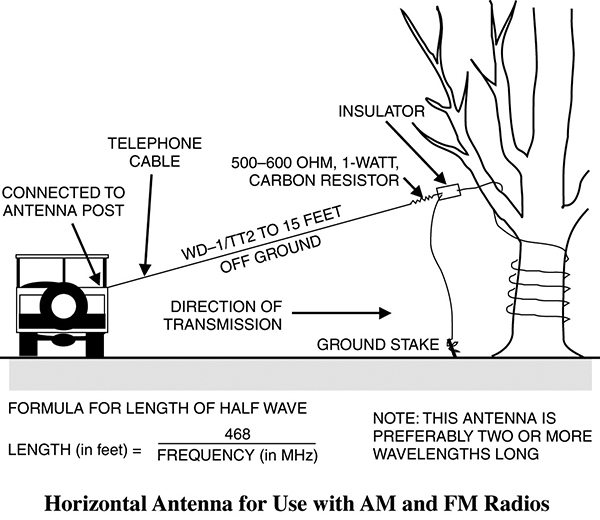
Long-Wire Antenna
The long-wire antenna is used with both AM and FM radios to increase the range. It is normally used in open terrain where installation can be accomplished with ease.
Length
5 or 7 wavelengths of operating frequency
Height
3 meters
Range
Up to 2 to 3 times the operating range of set
Resistor
400–700 ohms
Radiation
Without resistor—from both ends With resistor—off resistor end only
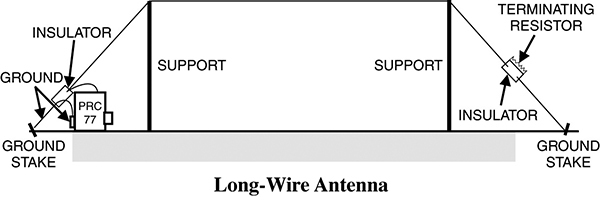
Vertical Half-Rhombic Antenna
The vertical half-rhombic antenna has the advantage of being smaller in physical size than the horizontal antenna and requires only one pole for construction. It can be made directional with the use of a resistor. The principal disadvantage is that if the angle between the antenna wire and surface of the earth is too small, the signal will be radiated at an upward angle that may be above the intended receiver. A typical vertical half-rhombic antenna consists of 100 feet of field wire WD-1/TT, erected over a single 30-foot support base. One leg of the antenna terminates at the resistor; the other end is connected from the insulator to the radio by a 5-foot lead-in wire.
Length
2 wavelengths of operating frequency, with a 5-foot lead-in
Height
20 meters
Range
Up to 2 to 3 times operating range of set
Resistor
400–700 ohms
Radiation
Without resistor—equally off both ends With resistor—off resistor end only
Note: A counterpoise is used as an additional ground in everyday climates. It is placed on top of the ground and installed from one ground stake to the other, and then to the battery case clip. If the counterpoise is not used, the ground lead-in is connected from the ground stake to the battery case clip. The insulators and the resistor are installed approximately knee high.
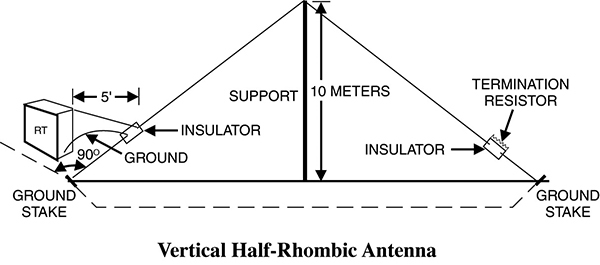
Appendix A
Rules of Engagement and Use of Deadly Force in Combat Zones
By David G. Bolgiano
This section is different from the rest of this manual because it is both impractical and unwise to write a “checklist” for when or how to use deadly force. One cannot write a linear “cheat sheet” for ROE and the Use of Force. Checklists are fine for packing lists, TTPs, quick reaction drills, and most other combat preparatory topics. They are very bad for comprehending and training on the topic of deadly force encounters. That is why ROE and Escalation of Force (EOF) cards provide poor tactical guidance.
Please take the time to read this appendix and understand the dynamics of such encounters and ways to train to the fight. It is important to be wary of any ROE or EOF card that uses legally and tactically incorrect language like: “Only use deadly force as a last resort,” “Do not shoot unless someone is pointing or shooting a weapon at you,” or “Do not shoot at fleeing hostile actors.” All of these examples are from prior real-world ROE cards—such language breeds confusion and unnecessary hesitation and has no basis in the law. They are attempts to cover up poor training and preparation. They demonstrate a lack of trust that must be assiduously avoided at all cost. Most of these have been properly removed from use, but you may still find similar language, so be forewarned. Nevertheless, because of their ubiquity and the expectation that units be provided with an ROE or EOF card, a good and legally supportable example is set forth below. Also, in the event of an investigation of yourself or a member of your unit as the result of a Use of Force situation, there are simple post-incident guidelines to follow.
HOW TO RESPOND WHEN INVESTIGATED
For those who may be the subject or target of a use of force investigation: Do not be intimidated by AR 15-6 investigators, Army CID, or anyone else. If you use deadly force in the line of duty, follow these guidelines.
1. Avail yourself of switched-on legal counsel before making a statement, especially a sworn statement. The right to counsel is not only for criminals: It is a right guaranteed for all Americans. It is perfectly reasonable to provide a quick situational report (SitRep) to your chain of command. They have a need to know enemy tactics and a need to provide higher headquarters with situational awareness on the incident. It is not reasonable, however, to question and obtain sworn statements from a soldier at two in the morning, thirty minutes post-incident. There are a number of reasons why this is true. Suppose at an entry control point (ECP) to a sensitive facility a soldier uses deadly force on a bulkily clad civilian-dressed female who fails to heed repeated warnings to halt. In a personal-borne improvised explosive device (PBIED) suicide bomber environment, such force may be perfectly reasonable. Suppose, however, that post-incident it is discovered that the bulkily clad civilian was merely a disoriented pregnant female seeking medical attention. A soldier, feeling guilty for an otherwise lawful use of force, may make self-incriminating, factually incorrect statements. The human mind, after a deadly force encounter, is often encumbered with intrusive thoughts, elation, guilt, and multiple compressed, inaccurate memories. For these reasons alone, it is provident to wait at least twenty-four hours before making a statement.
